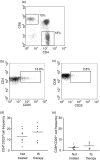Circulating and thymic CD4 CD25 T regulatory cells in myasthenia gravis: effect of immunosuppressive treatment
- PMID: 16108825
- PMCID: PMC1802400
- DOI: 10.1111/j.1365-2567.2005.02220.x
Circulating and thymic CD4 CD25 T regulatory cells in myasthenia gravis: effect of immunosuppressive treatment
Abstract
Accumulating evidence indicates an immunosuppressive role of the thymus-derived CD4+ T-cell population constitutively expressing high level of CD25, T regulatory (Treg) cells, in autoimmune diseases. Here we show that the number of Treg cells in the blood is significantly lower in untreated myasthenia gravis patients than in age-matched healthy subjects, whereas it is normal or elevated in patients on immunosuppressive therapy (prednisone frequently associated with azathioprine). Therapeutic thymectomy (Tx) for either the thymoma or non-neoplastic thymic alterations that are often associated with myasthenia gravis provided unique material for studying intrathymic Treg cells and correlating them with their peripheral counterparts. We observed that Tx prevents the increase of Treg cells in the circulation that follows immunosuppressive therapy (particularly evident if the thymus is not neoplastic), indicating that the thymus contributes to Treg-cell normalization. However, thymic Treg cells are not modulated by immunosuppressive therapy and even in thymectomized patients Treg-cell numbers in the blood eventually recover. The present findings suggest that a deficiency in Treg cells favours the development of myasthenia gravis and that their normalization is an important clinical benefit of immunosuppressive therapy. Treg normalization appears to be largely thymus independent and possibly reflects the reported capacity of corticosteroids to promote Treg-cell development.
Figures





References
-
- Drachman DB. Myasthenia gravis. N Engl J Med. 1994;330:1797–810. - PubMed
-
- Hohlfeld R, Toyka KV, Heininger K, Grosse-Wilde H, Kalies I. Autoimmune human T lymphocytes specific for acetylcholine receptor. Nature. 1984;310:244–6. - PubMed
-
- Sommer N, Harcourt GC, Willcox N, Beeson D, Newsom-Davis J. Acetylcholine receptor-reactive T lymphocytes from healthy subjects and myasthenia gravis patients. Neurology. 1991;41:1270–6. - PubMed
-
- Vincent A, Willcox N. The role of T-cells in the initiation of autoantibody responses in thymoma patients. Pathol Respiract. 1999;195:535–40. - PubMed
-
- Sakaguchi S, Sakaguchi N, Shimizu J, et al. Immunologic tolerance maintained by CD25+CD4+ regulatory T cells: their common role in controlling autoimmunity, tumor immunity, and transplantation tolerance. Immunol Rev. 2001;182:18–32. - PubMed
MeSH terms
Substances
LinkOut - more resources
Full Text Sources
Medical
Research Materials

